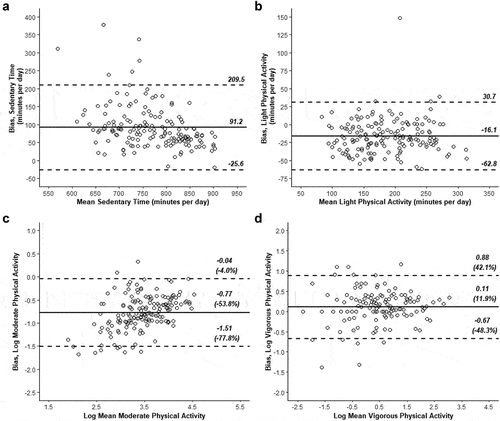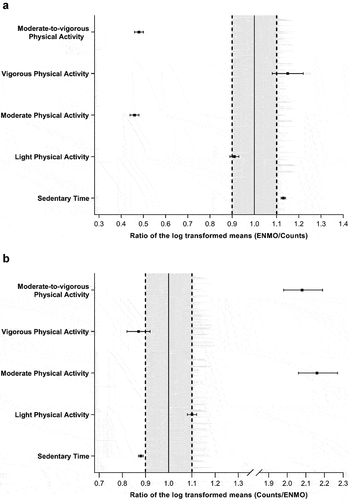Figures & data
Table 1. The site-specific thresholds used to determine activity classification for ENMO- and counts-based processing methods. These are the recommended thresholds to be used in adolescents (Migueles et al., Citation2017) .
Figure 1. Bland-Altman plots to represent agreement between the two methods, with counts processing as the reference, for sedentary time (A), light (B), moderate (C) and vigorous (D) physical activity during wrist-worn accelerometery in the full sample (n = 161). Solid lines represent the mean bias and dashed lines represent the 95% limits of agreement. The numerical values for the bias and limits of agreement are also presented. In panels C & D, the log transformed values are presented with the antilog percentages presented in parentheses.

Table 2. Summary of absolute agreement, consistency and equivalence between estimated time spent in each behavioural activity using the different processing methods for wrist-worn accelerometery (n = 161) .
Figure 2. A visual display of the paired equivalence testing for wrist-worn accelerometery (n = 161). Each row shows the ratio of the log transformed means for estimated time in each activity classification produced by the different processing methods. (A) Ratios when counts processing is used as the “reference”. (B) Ratios when ENMO processing is used as the “reference”. The ratios are presented with ± 90% CI’s. The shaded area represents the ± 10% zone of equivalence. In order to be equivalent, the ratio and CI’s should sit within the equivalence region.

Table 3. The 90% confidence interval (ENMO processing) and the minimum required zone of equivalence (counts processing) required to conclude equivalence for each activity behaviour, when considering counts processing as the reference. The equivalence zone is also expressed as proportion of the standard deviation for each activity estimate from counts processing. Data are for the full sample (n = 161) .
